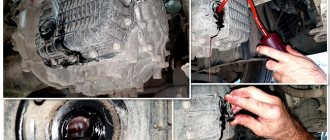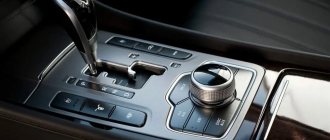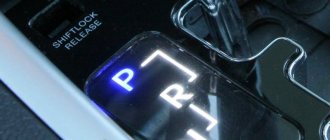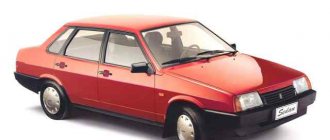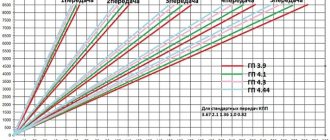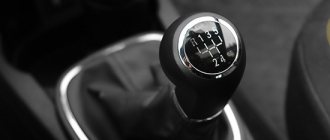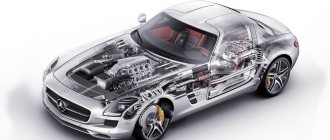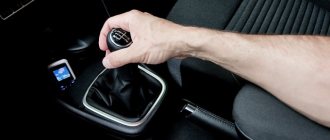The idea of creating an automatic transmission appeared almost simultaneously with the advent of a car equipped with a manual transmission. At the same time, automakers, inventors and enthusiasts from different countries began to work on the unit.
As a result, already at the very beginning of the 20th century, prototypes began to appear that had a transmission similar to a modern automatic machine. In this article we will talk about how the first automatic transmission was created and when it appeared, we will get acquainted with the history of the automatic transmission, and also answer the question of who invented the automatic transmission.
Automatic vs manual
Automatic transmissions are more convenient, especially when driving in city traffic jams.
It's hard to argue with that. However, compared to “mechanics” they are not without a number of disadvantages. For example, such as increased fuel consumption and a noticeable loss in dynamics. At least this follows from the official technical specifications. What is it really like? Are the differences between manual and automatic cars really as big in real life as they are on paper? We checked it. FOR COMPARISON, we took two brand new Ford Focus cars with identical 145-horsepower two-liter Duratec engines. But car No. 1 was equipped with a four-speed automatic transmission, and car No. 2 was equipped with a five-speed manual transmission.
According to the brief technical specifications declared by the manufacturer, a car with a manual transmission should accelerate to 100 km/h exactly 1.5 seconds faster. But this is theoretical, provided that an ideally trained tester is behind the wheel of the car, who will each time “twist” the engine strictly to optimal speed (when maximum output is achieved) and change gears at lightning speed. Can an ordinary driver who does not have sports driving skills cope with such a task in real life?
We measured the dynamics of acceleration on a straight deserted road using a satellite GPS navigator. The results of the first run of the blue Focus were somewhat puzzling - 11.75 s. Almost 12 - a lot! Where are the nine-something promised by the manufacturer? Another run, then another: 11.5 s. 11.34 p.m.
The best result that was achieved after a whole series of tests was 11.06 s. This is how much it took, one might say, for the average driver to accelerate to 100 km/h. The difference with the declared ideal indicator was almost two seconds. What time will a car with an automatic transmission show?
When accelerating in a car with an automatic transmission, absolutely no skills are required from the driver. At the signal, we turn the gas to the floor, and we wait until the GPS navigator beeps. The cherished 100 km/h was successfully achieved in 11.37 seconds. Moreover, this result is repeated over and over again with minimal deviations. Well. Let’s write it down like this: in real conditions, a car with an automatic transmission loses only a third of a second when accelerating to “hundreds”. But in general, our experience confirms the theory that a car with an automatic transmission accelerates a little slower.
In order to find out, we arrange a paired race, the cars start simultaneously parallel to the course. And what? At the first moment, a car with an automatic transmission is even slightly ahead. Approximately the first third of the distance (up to a speed of 50 km/h) accelerates a little faster. This is explained by the fact that a four-speed automatic transmission has a “longer” first gear than a five-speed manual transmission, and while the driver of the blue car wastes time switching to second gear, the car continues to accelerate in first.
Then the balance of power changes, and the car with a manual transmission takes the lead. It reaches 100 km/h first, but at this moment it is only one and a half lengths ahead of a car with an automatic transmission. Thus, the loss in dynamics is minimal. Let's just say that if, when starting from a traffic light, you are one and a half lengths behind the leader, then no one will be able to get between you anyway. He won’t even try - the interval is too small. And we must also take into account that when driving around the city, when most often you have to accelerate to 70-80 km/h (and not up to 100, as in our experiment), the advantage of “mechanics” may not appear at all.
WHAT ABOUT ECONOMY? We checked this too. Why, we filled both cars to capacity and set off on a 100-kilometer journey around Moscow, leaving the Moscow Ring Road and returning back to the city. So we modeled a kind of mixed (partly urban and partly suburban) cycle. Of course, we did not try to exactly repeat the laboratory measurement technique that automakers use when compiling technical specifications; we were interested in fuel consumption in real conditions.
The cars moved one after another in the same mode. We took measurements twice, driving in the morning and evening along the same route. Average data suggests that the blue car with a manual transmission required 9.6 liters of fuel per 100 km, and with an automatic transmission - 12.2. By the way, the obtained figures differ markedly from the reference ones. I hope there is no need to explain why? Nevertheless, in general, the theory is again confirmed: you have to pay for the convenience of driving with an automatic transmission. On average - 2.5 liters of gasoline for every 100 km.
How does a torque converter work?
The torque converter consists of the following main elements:
- pump or pump wheel;
- turbine wheel;
- blocking plates;
- stator;
- overrunning clutch.
To understand how an automatic transmission works, you need to understand its structure in general. Thus, the pump is connected to the engine by a mechanical connection. The turbine wheel is connected to the gearbox shaft using splines. When the pump wheel rotates while the engine is running, an oil flow is created, which rotates the turbine wheel of the torque converter.
It doesn't hurt to know when to change the oil in an automatic transmission.
In this case, the torque converter plays the role of a regular fluid coupling, only transmitting torque from the engine to the automatic transmission shaft through liquid. As engine speed increases, there is no significant increase in torque.
To convert torque, the automatic transmission circuit includes a stator. The principle of operation is that it redirects the flow of oil back to the pump impeller, causing it to rotate faster, increasing torque. The lower the speed of rotation of the turbine wheel relative to the pump, the greater the residual energy transferred by the stator through the return oil to the pump. Accordingly, the torque increases.
Basics of operation of the turbine and automatic transmission pump
The turbine always rotates slower than the pump. The maximum ratio of pump and turbine rotation speeds is achieved when the vehicle is stationary, decreasing as the vehicle speed increases. The stator is connected to the torque converter through an overrunning clutch that can only rotate in one direction.
The turbine and stator blades have a special shape, due to which the oil flow is redirected to the back side of the stator blades. In this case, the stator jams and, remaining motionless, transfers the greatest oil energy to the pump input.
Due to this mode of operation of the torque converter, maximum torque transmission is ensured. It increases almost three times when the car starts moving.
As the vehicle accelerates, the turbine slips less and less relative to the pump until the moment when the stator wheel is picked up by the oil flow and begins to rotate in the direction of the freewheel of the overrunning clutch. In this case, the device begins to work like a regular fluid coupling and does not increase torque. In this mode, the efficiency of the torque converter does not exceed 85%! This mode of operation is accompanied by the release of excess heat and increased fuel consumption.
Purpose of the blocking plate
This drawback is eliminated using a special device - a blocking plate. Despite the mechanical connection with the turbine, it is structurally designed in such a way that it can move left and right. This device comes into operation when the car reaches high speed. Upon command from the control device, the oil flow changes so that it presses the locking plate against the torque converter housing on the right.
In this case, the turbine and pump are connected to each other mechanically. To increase traction, a special friction layer is applied to the inside of the torque converter housing. In this way, the engine is connected to the output shaft of the automatic transmission. Naturally, such a lock is immediately turned off even with slight braking of the car.
We recommend: Replacing rings and valve stem seals: instructions with photos and videos
Only one method of locking a torque converter was described above. However, any other method has the same goal - to prevent the turbine from slipping relative to the pump wheel. Typically, the described mode of action in various sources is called Lock-Up.
It will be easier to understand the operation of a torque converter for dummies if, instead of a turbine and a pump, we imagine two simple fans, one of which is powered by the network, and the other rotates due to the air flow created by the first fan. Only instead of air, oil appears here, and the blades of the first fan (pump in the case of an automatic transmission) are driven not by electricity, but by a mechanical connection to the car’s engine shaft.
Types of automatic transmission
According to technicians, the hydromechanical automatic transmission is represented only by the planetary part of the unit. After all, it is responsible for changing gears and, together with the torque converter, is a single automatic device. The automatic transmission includes a classic hydraulic transformer, a robot and a variator.
Classic automatic transmission
The advantage of a classic automatic transmission is that the transmission of torque to the chassis is provided by the oil fluid in the torque converter.
This allows you to avoid clutch problems that are often detected when operating machines that have other types of gearboxes installed. If you maintain the box in a timely manner, you can use it almost forever.
Robotic gearbox
View of a robotic gearbox.
It is a kind of alternative to mechanics, only the design has a double clutch controlled electronically. The main advantage of the robot is considered to be fuel efficiency. The design has software installed, the work of which is to rationally determine the torque.
The box is called adaptive, because it is able to adapt to your driving style. Most often, the clutch breaks in a robot, because... it cannot bear heavy loads, such as when driving in difficult terrain.
Variable speed drive
The device provides smooth, stepless transmission of torque to the vehicle chassis. The CVT reduces gasoline consumption and improves dynamics, providing the engine with a gentle operating mode. Such an automated box is not durable and does not tolerate heavy loads. Inside the unit, parts constantly rub against each other, which limits the life of the variator.
Types of automatic transmissions and their differences
The operating principle of all types of automatic transmissions comes down to changing the gear ratio, which ensures the conversion of engine power. Manufacturers of modern cars install the transmission in such a way that the full potential can be used. Due to the operation of the automatic transmission, force is transmitted from the engine to the wheels of the car with the smallest losses. This is achieved due to the absence of clutch rupture.
The driver changes gears by pressing the gas pedal. At the same time, the engine spins up, causing the pump wheel to move. From the blades, under the influence of centrifugal force, the engine oil passes to the turbine, ensuring rotation. As a result, the liquid flows back to the pump wheel.
In some automatic transmissions, at a speed of 20-60 km/h, the torque converter is automatically locked by the clutch. In this case, the automatic transmission is tightly coupled to the engine, so the loss of power is not noticeable. Interestingly, when used under such conditions, the oil quickly becomes unusable due to overheating and wear of the friction lining. The torque from the engine passes through the output shaft to the automatic transmission.
Automatic transmission occupies a leading position among all known options. New systems are constantly being developed and improved. From the general lists, we can distinguish CVT, robotic and classic types.
Classic automatic transmission
The torque converter module is still popular, despite the presence of other, more advanced options. This transmission is still in use today. It is installed on cars coming off the assembly line.
Standard automatic transmission
The automatic transmission includes a planetary gearbox, a control system and a hydraulic transformer. The last element of the mechanism is the most significant, hence the name of the design. The module is actively used on cars and trucks.
Who is a car with automatic transmission suitable for? Probably only for beginners. It can be quite difficult for even experienced car owners to drive an automatic transmission after a manual transmission. Many owners, despite the apparent simplification of the operating mode, find it difficult to adapt.
Robotic
The robotic gearbox is a worthy and modern alternative to the classic automatic transmission. Switching speeds in it is ensured due to the interconnection of electrical mechanisms that are active due to the electronic unit. The main similarity of this system with the classic one is the presence of a clutch in the gearbox housing.
Robotic automatic transmission
Variable speed drive
This is a planned continuously variable transmission device that ensures the transmission of torque to the wheels. This design produces reduced fuel consumption while maintaining or increasing dynamic performance.
Variable speed drive
When used correctly, the variator helps to carefully operate the vehicle's engine. The module can be chain, belt and toroidal.
Excellent article on the topic: CVT or automatic: which is better and more reliable, pros and cons, how gearboxes differ, what is the difference
DSG
DSG is also a robotic system that provides automatic engagement of first and second speed when the clutch is open. This is how the module begins to prepare for upshifting. When switching, the clutch of the first stage opens and the second closes; the action also occurs in the reverse order.
DSG-7
The similarity with mechanics is that synchronizers are able to change speed when the gear is locked. The operation of the couplings is ensured by the movement of the cylinders. The clutch operates by hydraulic drive.
Multi-shaft direct shift boxes
Such gearboxes are used in sports cars. For example, Koenigsegg Jesko uses a gearbox with 3 shafts, 9 gears and 7 clutches. The car can instantly switch to sport mode and economical city mode. This is regulated using a button: half-pressing the left button reduces the gear, full pressing turns on the sports gear. If you press halfway on the right one, the gear will increase, if you press it all the way, the economy will turn on.
And some sports Mercedes have an automatic transmission with a clutch, which is similar in driving style to the above, but has completely different internal components.
Three-shaft 6-speed gearbox Mercedes-Benz C-class sport coupe
Our days
A modern automatic transmission is a well-oiled mechanism controlled by a special electronic unit. With the help of numerous sensors, the automatic transmission is able to control operating modes and display the necessary information on the screen of the car’s on-board computer.
5, 6, 7 and even 8-speed automatic transmissions were invented, which allow the driver to enjoy smooth acceleration and comfortable handling of a vehicle for any purpose:
- passenger cars;
- light trucks;
- SUVs;
- road and agricultural machinery;
- minibuses and full-size buses.
Servicing your automatic gearbox in specialized centers and using high-quality consumables and transmission fluids ensures its trouble-free operation for many years.
Over the course of several decades, the inventors of the automatic transmission and their many followers have been coming up with a new design and adapting this mechanism to modern human life. Even today, the development stage of automatic transmission cannot be called complete.
What is an automatic transmission
What is an automatic transmission - this is an abbreviated name for Automatic Gear Shift, it allows the driver not to change gear manually when the car picks up speed or reduces it, smart electronics does it for him, choosing the optimal moment to engage an upshift or the moment to engage a downshift, the driver remains just select the direction on the shift selector forward or backward and press the brake or gas pedal depending on the need, there is no clutch pedal with such a box, there is only gas and brake.
Here, for example, are ordinary photos of some types of automatic transmissions in automobile gearboxes. For many mechanical enthusiasts, these symbols do not mean anything, but only confuse them more and distance them from the automatic transmission.
Therefore, let's try to dispel the fog of doubt and ignorance by explaining the meaning of each symbol on the automatic transmission:
- R – translated in English as Parking, parking or parking. The car is switched to this mode only after a complete stop. If you are standing on a hill, it is recommended to first put the car on the handbrake and only then move the lever to the Parking position, after which you can leave the car and go about your business
- R - literally Reverse, back, back - that is, normal reverse gear, engage it when there is a need to drive in reverse
- N - translated as Neutral, that is, neutral, neutral speed, it is mainly used for towing a car, usually when standing in a traffic jam, it is recommended to hold the brake pedal without moving the car to the neutral position - since this is not a manual transmission, but nevertheless, many automatic transmission owners when parking, especially in traffic jams, move the lever to position N, because you must admit that keeping your foot on the pedal for 20-30 minutes is not at all comfortable
- D or A - you can find both of these designations Drive or Automate, which is essentially the same thing, that is, you switch to this position when you need to drive, squeeze the brake, put the speed lever in position D or A and simply press the gas pedal, smoothly releasing the pedal brakes and all movement has begun, now there is no need to switch the handle, just regulate the speed of your movement by pressing the gas pedal in your car with your foot
- L or B (l, 1, 1L) - some types of automatic transmissions are equipped with additional functions (Low or Bottom) which can literally be translated as slow or first gear. Typically used on ice, very steep descents or uphills, or for engine braking.
- B or simply Block often means differential locking, usually on jeeps or all-wheel drive cars, in which cases it is better to read the manual for your car model
- 2 or 2L, 3 or D3, 4 or D4 - means limiting the speed switching by the gearbox, that is, set it to 2 - it means the gearbox will not shift above second gear no matter how hard you press on the gas, set it to mode 3 - the box will not shift above third gear will switch no matter what you do with the accelerator pedal, the same will happen in 4 - the shift will not occur above the fourth speed, for example, you have 6 steps in the box, you set it to mode 4 - this means the car itself will shift from 1st to 4th gear, auto to 5th -and 6 will no longer switch
Operating principle of automatic transmission
Several types of automatic transmissions with their own characteristic features are installed on vehicles.
In a simplified way, the mechanism of operation of a classic automatic transmission consists of transmitting torque from the engine crankshaft to transmission devices, while the gear ratio varies in accordance with the position of the selector lever and the driving conditions of the vehicle.
When the engine starts, working fluid enters the hydraulic transformer and the pressure increases. The blades of the centrifugal pump begin to move, the reactor wheel and the main turbine are motionless in this mode.
When you switch the selector lever and supply fuel using the accelerator pedal, the pump blades increase speed. The increasing speed of the vortex flows begins to rotate the turbine blades. The oil vortices either spread to the stationary reactor or return back to the turbine, increasing its efficiency. The torque is transferred to the wheels, and the car begins to move.
Upon reaching the required speed, the pump wheel and the bladed central turbine move at the same speed, while the vortices of the transmission fluid enter the reactor wheel from the opposite side (movement is possible only in one direction) and it begins to rotate. The unit switches to the hydraulic coupling state.
If the resistance to the wheels increases (uphill movement), the reactor wheel stops rotation and adds torque to the centrifugal pump. When the required speed and torque are reached, the gear in the planetary unit changes.
The electronic control unit transmits a command, as a result of which the braking band and friction discs slow down the downshift, and the increased movement of fluid flows through the valve accelerates the upshift and ensures gear changes without reducing power.
When the machine stops completely or the speed decreases, the pressure of the working fluid decreases and the gear decreases.
When the engine is stopped, there is no pressure in the torque converter, so starting the car with a push is impossible.
Automatic transmission device
A classic slot machine has 4 main components:
- Hydraulic transformer. In cross section it looks like a donut, which is why it received the corresponding name. The torque converter protects the gearbox in case of rapid acceleration and engine braking. Inside there is transmission oil, the flow of which provides lubrication to the system and creates pressure. Due to it, a clutch is formed between the engine and transmission, and the torque is transmitted to the chassis.
- Planetary reductor. Contains gears and other working elements driven around one center (planetary rotation) using a gear train. The gears are given the following names: central - sun, intermediate - satellites, external - crown. The gearbox has a planetary carrier, which is designed to fix the satellites. To change gears, some gears are locked while others are driven.
- Brake band with a set of clutches. These mechanisms are responsible for engaging gears and, at the right moment, blocking and stopping the elements of the planetary gear. Many people do not understand why a brake band is needed in an automatic transmission. It and the clutch are sequentially engaged and disengaged, which leads to the redistribution of torque from the engine and ensures smooth gear shifting. If the belt is not adjusted correctly, jerking will be felt when moving.
- Control system. Consists of a gear pump, oil sump, hydraulic unit and ECU (electronic control unit). The hydraulic unit has monitoring and management functions. The ECU receives data from various sensors about driving speed, choosing the optimal mode, etc., thanks to which the automatic transmission is controlled without driver participation.
Gearbox design.
Subtleties of operating an automatic transmission
In order for the driver to start moving, he needs to move the selector to the appropriate position and turn off the handbrake. If you gradually release the pressure on the brake, the car will begin to move smoothly. When a faster start is required, press on the gas, so the gears will begin to increase.
At the same time, deceleration is achieved by reducing the impact, and stopping by taking your foot off the accelerator and downshifting. To make a sudden stop, take your foot off the gas and apply the brake. And to start active movement again, they simply press the gas.
Attention:
Before you start driving, you need to remember the rule - the car must be warmed up for several minutes. When it’s cold outside, the engine should run for at least 10 minutes, while it is advisable to switch gearbox modes several times. Thus, the oil will heat up to operating temperature faster, and the degree of wear will be significantly reduced.
Important Recommendations:
What is automatic transmission and the history of its creation
An automatic transmission is a transmission that, without driver intervention, selects the optimal gear ratio according to driving conditions. The result is a smooth ride and comfort for the driver.
Gearbox control.
History of invention
The basis of the automatic machine is considered to be a planetary gearbox and a torque converter, which was created by the German Hermann Fittenger in 1902. The invention was initially intended to be used in the field of shipbuilding. In 1904, the Startevent brothers from Boston presented another version of the automatic transmission, consisting of 2 gearboxes.
The first cars on which planetary gearboxes were installed were produced under the name Ford T. The principle of their operation was as follows: the driver switched the driving mode using 2 pedals. One was responsible for upshifting and downshifting, the other provided reverse movement.
In the 1930s, General Motors designers released a semi-automatic transmission. The cars still had a clutch, but hydraulics controlled the planetary mechanism. Around the same years, Chrysler engineers added a fluid coupling to the box. The two-speed gearbox was replaced by overdrive - an overdrive gear where the gear ratio is less than 1.
The first automatic transmission appeared in 1940 at General Motors. It combined a fluid coupling and a four-speed planetary gearbox, and automatic control was achieved through hydraulics.
Pros and cons of automatic transmission
Each type of transmission has its fans. But the hydraulic automatic machine does not lose its popularity because it has undoubted advantages:
- gears are activated automatically, which promotes complete concentration on the road;
- the process of starting movement is made as easy as possible;
- the chassis and engine are operated in a more gentle mode;
- The cross-country ability of cars with automatic transmission is constantly improving.
Despite the presence of advantages, car enthusiasts identify the following disadvantages in the operation of the machine:
- there is no possibility to quickly accelerate the car;
- engine response is lower than that of a manual transmission;
- the vehicle cannot be started from a pusher;
- the car is difficult to tow;
- improper use of the box leads to damage;
- Automatic transmissions are expensive to maintain and repair.
Starting a car with automatic transmission
So, how to start a car automatically? First of all, you need to start it with P or N, they turn on when you press a special button.
Better, since “Neutral” is more related to the service system, thereby separating the engine and gearbox. To start moving, you should switch to “Drive” without releasing the brake to release the lock.
Do I need to warm up my car before driving?
There is no point in warming up a car with an automatic transmission if the temperature outside is not below zero and there is no frost. When starting the engine, wait a few minutes for the oil to circulate. If the car is installed in “Parking” and turned off, then, in principle, it already runs through the oil.
It is recommended that in severe frost and the box is not heated, do not use powerful pumps to avoid damage.
How to drive with automatic transmission
How to drive an automatic car correctly for beginners and what features you might encounter?
Here's how to start an automatic car:
- Press the brake pedal.
- Remove the lever from “P”.
- Set Drive or other auxiliary gear.
- Release the gas pedal.
The car will start moving spontaneously, without pressing the gas pedal. Brake automatically The box is operated using a motor and special buttons.
Driving a car with an automatic transmission in traffic jams and traffic lights
You need to understand how automatic transmissions work. In congestion conditions, or when there is heavy traffic on the road, the engine should not be running, so turn on “Neutral”.
In neutral, the engine does not work, but the vehicle can travel about 5 km. The mode saves fuel and protects the car from repairs. At traffic lights the situation is the same, but you can use additional gears, for example - 2, they will help you move off smoothly with an automatic transmission.
Stopping on a hill using automatic transmission
- Release the brake smoothly, adjusting the speed of descent.
- You climb the climb.
- You slow down.
- Set the lever to Neutral and the engine stops running.
- Turn on Parking, ensuring safe parking of vehicles, blocking traffic.
- Take your foot off the brake and within a few seconds the car will be in the correct position.
"S" mode
Many have S installed and it denotes dynamic use. That is, an additional system where vehicles can be accelerated to a certain speed, it quickly starts and accelerates, and overtakes. Another name for it is sports.
It depends on the car model and its class; the more powerful the car, the better “Sport” works. With such a system, a large load is placed on the engine, body and the tires themselves.
Mode "E"
There are other designations for automatic. gearbox, for example, the E icon indicates an economical trip. Provides smooth, easy and quiet driving speed, thereby saving gasoline or diesel even in the cold season.
It's icy outside, and the economical dir. allows you to feel safe on the road.
Descent to automatic transmission
There are descents: sharp and protracted, but the instructions are the same for each. It is not recommended to descend using the brake pedal depressed; you can only slow down.
The operating principle is usual:
- the lever is set to “Drive”;
- the gas pedal is pressed;
- don't forget to put the handbrake down.
They use transmissions such as r. 1, r. 2. But the car does not always drive slowly on them.
How to overtake in a car with automatic transmission
Overtaking is a serious matter, you should take such a step more decisively, confidently and consciously. The box has additional modes for performing this maneuver. With them, the car drives quickly, picking up speed and confidently overtaking the nearest car.
There are certain rules under which overtaking is not allowed, but if you feel confident, then use “Sport” and quickly overtake. Please note that fuel consumption is maximum.
How to tow a car with an automatic transmission
To begin, move the lever to “Neutral”, carefully watch the car in front of you on the cable. Do not jerk the steering wheel and remember to stop every 30 minutes - this is a rule about the safety of the gearbox so that a breakdown does not occur.
The engine does not work, so no oil gets in.
How to stop moving correctly
To start moving, press the brake pedal and stop the car, then set “Parking”, which blocks movement.
Pull the handbrake on the car and release the brake, turning off the engine.
How to brake with an engine
The machine has its own nuances. They usually slow down on a slope or where you constantly have to hold the brake pedal. When braking, switch to manual, that is, r. 2 or 3.
Who invented the automatic transmission and when did the first automatic transmission appear?
As you know, the transmission is the second most important unit after the internal combustion engine. At the same time, the appearance of automatic transmission was a real breakthrough, since thanks to such a gearbox not only comfort, but also safety when driving a car is significantly increased.
Today there are several types of “automatic machines”: hydromechanical gearbox, variator, robot with one or two clutches. Let us immediately note that with regard to the first automatic transmissions, in this case we are talking about a hydromechanical planetary gearbox.
Such a gearbox is a system consisting of a torque converter (GDT) and a planetary gearbox. The principles and basics of planetary gearing were known back in the Middle Ages, and the torque converter was created by the German Hermann Fettinger at the beginning of the 20th century.
The first to combine the box and the gas turbine engine was the American inventor Azatur Sarafyan, better known as Oscar Banker. It was he who patented an automatic transmission in 1935, although to obtain a patent he defended his right in the fight against large automakers for more than 7 years.
Sarafyan was born in 1895. His family ended up in the United States as a result of the infamous Armenian Genocide, which took place in the Ottoman Empire. Having settled in Chicago, Asatur Sarafyan changed his name, becoming Oscar Banker.
The talented inventor created various useful devices, among which there are several solutions that are indispensable today (for example, a grease gun), but his main achievement is the invention of the first automatic hydromechanical gearbox. In turn, General Motors (GM), which previously installed a semi-automatic transmission on its models, was the first to switch to automatic transmission.
Automatic communism: how automatic transmission was developed in the USSR
At the end of the last century, domestic motorists saw with their own eyes unprecedented automotive options - electric mirrors and windows, air conditioners and automatic transmissions, which in our time have become commonplace even in the budget segment. But it’s curious that similar “bells and whistles” were also found on Soviet cars! Today we will talk about the history of the appearance and technical features of automatic transmissions on Soviet passenger cars.
Start
Back in the thirties, the USSR began to seriously study hydraulic couplings and torque converters, for which the Bureau of Hydraulic Gearboxes was created in Leningrad.
The history of the creation of an automatic transmission
So, the most important element that made the appearance of a full-fledged automatic transmission possible is the torque converter.
Initially, gas turbine engines appeared in shipbuilding. The reason is that instead of low-speed steam engines, more powerful steam turbines appeared towards the end of the 19th century. Such turbines were connected directly to the propeller, which inevitably led to a number of technical problems.
The solution was the invention of G. Fettinger, who proposed a hydraulic machine, where the blade wheels of the hydrodynamic transmission, pump, turbine and reactor were combined in one housing.
Such a torque converter was patented in 1902 and had a large number of advantages over other mechanisms and devices that could convert torque from the engine.
Fettinger's gas turbine engine minimized losses of useful energy, and the efficiency of the device turned out to be high. In practice, the specified hydrodynamic transformer, on average, provided an efficiency of about 90% or even more on ships.
Let's return to gearboxes on cars. At the very beginning of the 20th century (1904), inventors the Sturtevent brothers from Boston, USA, introduced an early version of the automatic transmission.
This two-gear gearbox was actually an improved manual transmission, where shifts could be automatic. In other words, it was a prototype robot box. However, in those years, for a number of reasons, mass production turned out to be impossible, and the project was abandoned.
Ford was the next to start installing automatic transmissions. The legendary Model-T was equipped with a planetary gearbox, which received two forward speeds as well as a reverse gear. The gearbox was controlled using pedals.
Then a box from the Reo company appeared on General Motors models. This transmission may well be considered the first manual transmission, since it was a manual gearbox with an automated clutch. A little later, a planetary gear system began to be used, bringing even closer the moment of the appearance of full-fledged hydromechanical automatic transmissions.
The planetary mechanism (planetary gear) is best suited for automatic transmissions. To control the gear ratio as well as the direction of rotation of the output shaft, individual parts of the planetary gear are braked. In this case, relatively small and constant efforts can be used to solve the problem.
In other words, we are talking about automatic transmission actuators (clutches, band brake). Also in those years, implementing effective management of these mechanisms was not difficult. There was also no need to equalize the speeds of individual automatic transmission elements, since all planetary gears are in constant mesh.
If we compare such a scheme with attempts to automate the operation of a manual transmission, at that time it was an extremely difficult task. The main problem was that in those years there were no effective, fast and reliable servomechanisms (servo drives).
These mechanisms are necessary to move the gears or clutches to engage them. Servo mechanisms must also provide a large force and stroke, especially when comparing the force for compressing the clutch pack or tightening the automatic transmission band brake.
A high-quality solution was found only closer to the middle of the 20th century, and robotic mechanics became widespread only in the last 10-15 years (for example, AMT or a DSG preselective gearbox).
What gearbox do sports cars have?
Transmission
- usually with manual switching, 6-speed (5-speed on older models), less often, in more expensive models - automatic or combined with electronic control.
Interesting materials:
How much will the MTPL policy cost? How much will it cost to replace hydraulic lifters on a Priora? How much will it cost to install a barrier? How much will it cost to import a car from America? How much will it cost to travel on minibuses in Odessa? How much will customs clearance of a car from Kazakhstan to Russia cost? How much will insurance cost after an accident? How much will it cost to sign up for insurance without experience? How many Tiger tanks were produced? How many hours should schoolchildren study?


